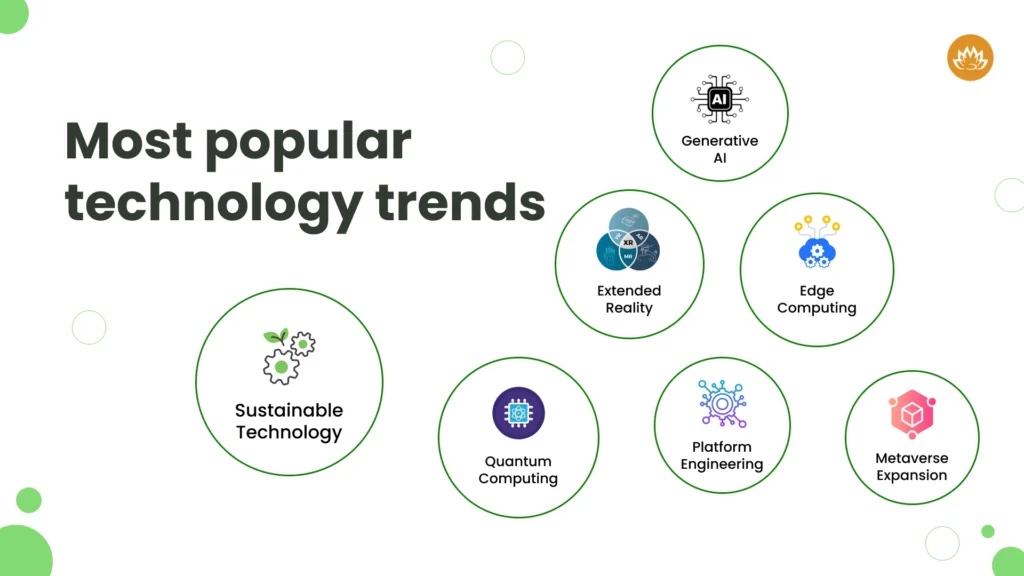
Google’s quantum chip solved a problem in minutes that would take traditional supercomputers 10 septillion years, it became clear — we’re not just stepping into the future, we’re leaping into it. 7 Groundbreaking trends that are transforming how we live, work, and interact with technology.
1. The Rise of Autonomous AI: Beyond Simple Automation
AI systems that don’t just follow instructions but actively plan and execute complex tasks on their own. That’s exactly where we’re heading in 2025.
The Financial Impact
The numbers are staggering. Generative AI spending is set to explode from a modest 2% to a whopping 12% of total tech spending by 2032, reaching $1.4 trillion. But here’s the interesting part — it’s not just about the money.
What’s Really Changing?
Traditional APIs and microservices follow predefined rules, like a well-trained dog performing tricks. But these new AI agents? They’re more like independent problem solvers. They can:
- Plan complex workflows autonomously
- Adapt strategies in real-time
- Make intelligent decisions without human input
- Bridge gaps between traditionally siloed systems
Real-World Applications
In healthcare, AI isn’t just assisting — it’s revolutionizing diagnostics. Radiologists are seeing faster, more accurate analyses of medical images, leading to better patient outcomes. Creative industries are experiencing a similar transformation, with AI handling everything from interior design to CGI character generation in Hollywood.
2. Green Tech: The Sustainable AI Revolution
Environmental concerns aren’t just buzzwords anymore — they’re driving real change in how we power our AI infrastructure.
The Green Transformation
- AI-powered cooling systems are cutting data center power usage by 40%
- Edge computing is reducing transmission-related emissions
- Renewable energy and nuclear power are becoming the backbone of AI operations
Even with potential political shifts on the horizon, major tech players aren’t backing down. Microsoft’s commitment to becoming carbon-negative by 2030 is setting a new industry standard.
3. Extended Reality (XR): The New Digital Frontier
While Apple’s Vision Pro might not have taken over the world yet, XR is quietly revolutionizing industries behind the scenes.
Beyond Gaming and Entertainment
The XR market is projected to hit $62 billion by 2029, but the real story isn’t in consumer gadgets. It’s in how XR is transforming:
- Remote operations of complex machinery
- Professional training and simulation
- Industrial design and prototyping
- Customer experience in retail
The Multi-Sensory Revolution
We’re moving beyond visual immersion. Advanced haptic feedback and gesture recognition are creating truly immersive experiences that you can feel and interact with naturally.
4. AI Democratization: The Global Tech Revolution
Here’s something that might surprise you — the next big AI breakthrough might not come from Silicon Valley. Emerging markets are leading a quiet revolution in AI innovation.
Global Innovation Stories
- India: AI-powered healthcare solutions reaching underserved populations
- Brazil: Smart city initiatives transforming urban mobility
- Nigeria: Using AI to tackle infant mortality
- Malaysia: Establishing itself as a regional AI hub
The Language Revolution
Over 25 countries have developed their own national language models, ensuring AI development isn’t limited to English-speaking regions.
5. Physical AI: When Digital Meets Physical
The robotics market is set to double to $179 billion by 2030, but this isn’t about factory automation anymore.
Real-World Applications
- Smart waste sorting systems
- Autonomous infrastructure inspection
- AI-powered urban maintenance
- Intelligent traffic management
The integration of AI into physical systems is creating a new category of intelligent machines that can interact with and adapt to their environment in real-time.
6. Synthetic Data: The Privacy Solution
One of the biggest challenges in AI development has been accessing quality data while maintaining privacy. Synthetic data is changing this landscape entirely.
Breaking Down Barriers
- Generate realistic, statistically accurate data
- Eliminate privacy risks
- Enable training in data-scarce scenarios
- Ensure regulatory compliance
Industry Impact
Financial institutions, healthcare organizations, and government agencies can now train advanced AI models without compromising sensitive information.
7. Quantum Computing: The Future is Now
When NVIDIA’s CEO suggested quantum computing wouldn’t be useful for 20 years, he might have underestimated the pace of innovation.
Current Applications
- Optimizing high-frequency trading
- Streamlining global supply chains
- Accelerating drug discovery
- Revolutionizing cryptography
Accessibility
Cloud-based quantum platforms like D-Wave’s Leap and IBM’s Qiskit are making quantum computing accessible to businesses today.
Looking Ahead
What makes 2025 truly revolutionary isn’t any single trend — it’s how these technologies are converging to create something entirely new. We’re seeing:
- AI systems that can think and act autonomously
- Physical systems that can learn and adapt
- Computing power that defies traditional limits
- Global innovation that breaks down barriers
The question isn’t whether these technologies will transform industries — they already are. The real question is: How will you adapt to stay ahead of the curve?
The tech landscape of 2025 isn’t just an evolution of what we have today — it’s a fundamental reimagining of what’s possible. From quantum breakthroughs to sustainable AI, from global innovation to physical computing, we’re witnessing the birth of a new technological era.
The winners in this new landscape won’t just be those who adopt these technologies first, but those who understand how to integrate them strategically into their operations. The future isn’t just coming — it’s already here.
